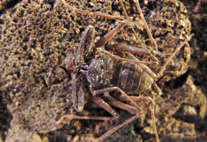Abstract
Triatoma melanocephala Neiva & Pinto is found in the Brazilian states of Bahia, Paraíba, Pernambuco, Rio Grande do Norte, and Sergipe. In addition to the species' specific description, eight other articles on this insect were found in the literature. In this study, data was obtained on the morphology, morphometry, and life cycle of T. melanocephala, since this vector is of epidemiological and taxonomic importance. The specimens studied were obtained from a colony that has been kept at the Triatomine Insectarium of the College of Pharmaceutical Sciences of São Paulo State University’s in Brazil. The morphological studies were performed using scanning electron microscopy. These studies characterized the eggs, the external adult female genitalia, and the ninth ventral abdominal segments of male and female nymphs. The morphometric studies characterized the five nymphal instars and the adult stage by measuring the head, thorax, abdomen, antennae, and mouthparts parameters. The life cycle of T. melanocephala was developed starting by 15 couples in the fifth instar. They were fed on Swiss mice every two weeks and observed daily. During daily observation, minimum temperature, maximum temperature, and relative humidity of the laboratory were measured. The results of the biological, morphometric, and morphological studies have increased the knowledge available on T. melanocephala.

